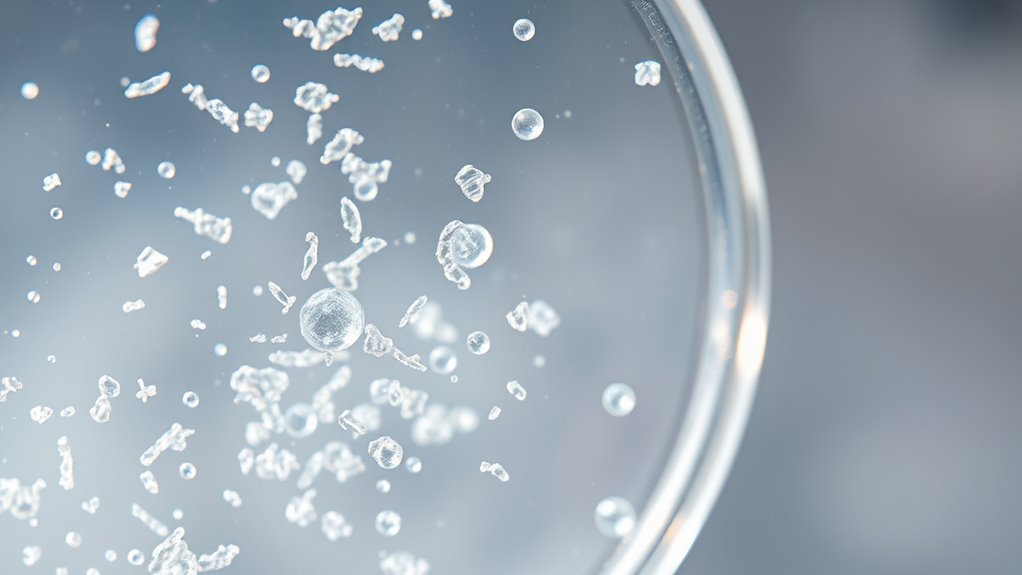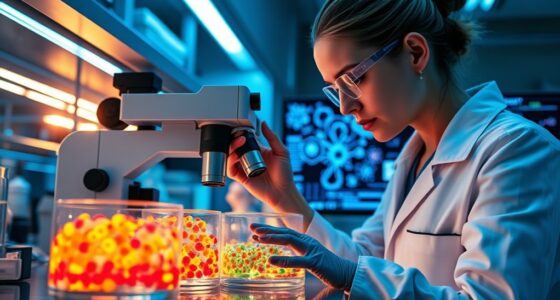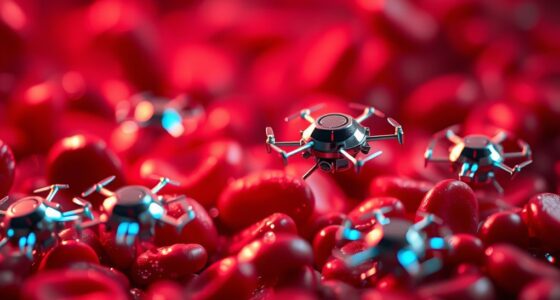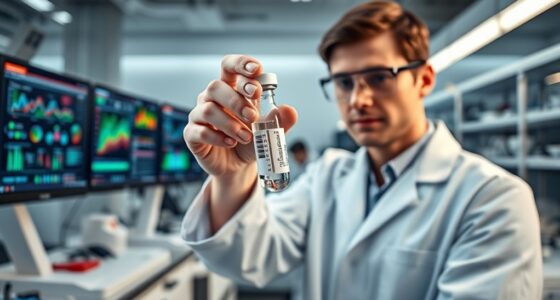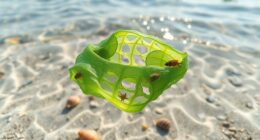Microplastics have been found in human blood and breast milk, raising serious health concerns. This means tiny plastic particles from everyday products are entering your body and potentially accumulating in tissues. They can carry harmful chemicals that may cause inflammation or other health issues over time. The discovery highlights how widespread microplastics are in our environment and bodies. To understand more about what this means for your health and what can be done, keep exploring further.
Key Takeaways
- Microplastics have been detected in human blood and breast milk, indicating widespread internal exposure.
- Their presence raises concerns about potential health risks, including inflammation and chemical toxicity.
- Microplastics can carry harmful chemicals that may transfer into the human body through ingestion or contact.
- Sources include plastic breakdown, microbeads, and shedding fibers from clothing.
- Policymakers and industries are working to reduce microplastic pollution and protect public health.
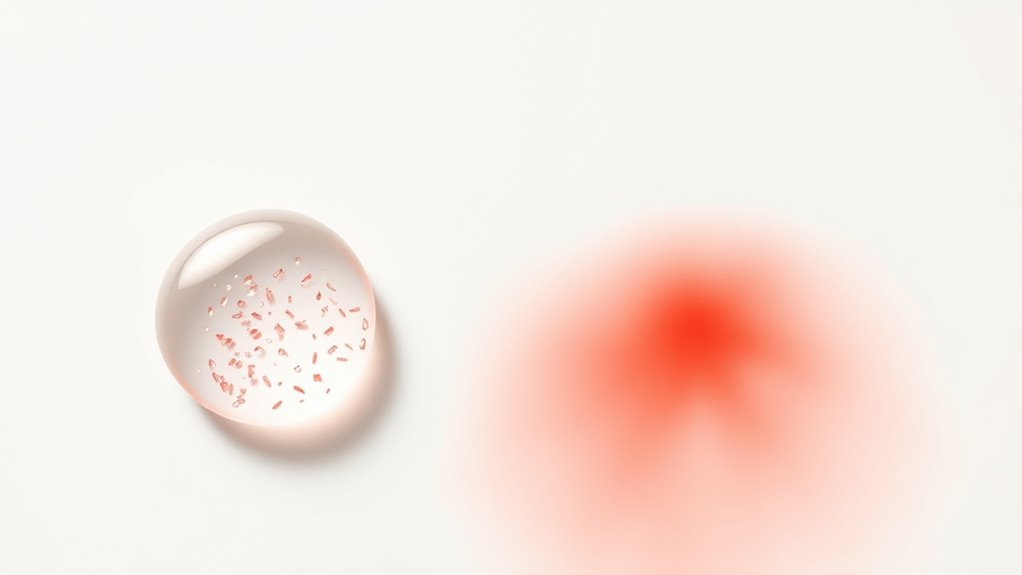
Have you ever wondered if tiny plastic particles are lurking in your body? Recent studies have confirmed that microplastics, which are minuscule plastic fragments less than five millimeters in size, have been detected in human blood and even breast milk. This revelation raises urgent questions about the widespread presence of these pollutants and their long-term health effects. When microplastics enter your bloodstream, they don’t just pass through; they can accumulate in tissues, potentially causing inflammation or other health issues. But their presence isn’t just a personal health concern—it signals a broader environmental crisis. Microplastics originate from countless sources, including the breakdown of larger plastic debris, microbeads in personal care products, and synthetic fibers from clothing. As these particles infiltrate ecosystems, they impact marine life, terrestrial animals, and ultimately, humans. The environmental impact of microplastics is profound, disrupting food chains, contaminating water supplies, and contributing to pollution in ways that are difficult to reverse. Their pervasive nature makes addressing this issue complex, especially when considering policy implications. Governments and regulatory agencies worldwide are now grappling with how to regulate microplastic pollution effectively. Policies aimed at reducing plastic waste, banning microbeads, and promoting sustainable materials are steps in the right direction, but enforcement remains challenging. You, as a consumer, can influence these policy shifts by supporting legislation that limits plastic production and improves waste management. Education campaigns are also essential, as they raise awareness about reducing plastic use and recycling properly. Industries need to adopt safer practices, like phasing out microbeads and developing biodegradable alternatives, to minimize further environmental contamination. On a broader scale, international cooperation is indispensable because microplastics don’t respect borders—they drift through air and water, spreading across continents. Implementing stricter standards and holding corporations accountable are critical policy implications that can help stem the tide of plastic pollution. While individual actions matter, systemic change driven by policy is indispensable for tackling the root causes. Recognizing that microplastics are now part of our internal biological landscape underscores the urgency of holistic solutions. The presence of microplastics in human blood and breast milk isn’t just a health concern; it’s a stark reminder of our collective responsibility to protect the environment. Effective policies can limit future exposure, reduce environmental impact, and safeguard public health. Additionally, the high surface area of microplastics makes them particularly adept at absorbing and transporting harmful chemicals into the human body. Understanding the pathways of exposure is crucial for developing targeted interventions to reduce health risks. Furthermore, microplastic toxicity is an area of ongoing research that continues to reveal potential long-term health consequences that we are only beginning to understand. Recognizing the pervasive nature of microplastics emphasizes the need for comprehensive solutions. It’s time to demand stronger regulations, support sustainable innovations, and push for a cleaner, healthier planet—because what’s in your body reflects what’s happening in the world around you.
Frequently Asked Questions
How Do Microplastics Enter the Human Body?
You can get microplastics in your body through plastic ingestion and inhalation pathways. When you eat seafood, drink from plastic bottles, or consume processed foods, small plastic particles may enter your digestive system. Breathing in air contaminated with microplastics from synthetic fibers or dust also allows these particles to reach your lungs and bloodstream. Both routes contribute to the accumulation of microplastics inside your body.
Are Certain Populations More at Risk of Microplastic Exposure?
They say “knowledge is power,” and understanding risks helps you protect yourself. Certain vulnerable populations, like children, pregnant women, and those with compromised health, face higher microplastic exposure. Geographic disparities also play a role, with communities near industrial areas or polluted waters at greater risk. You should stay informed about local conditions and minimize exposure, especially if you belong to these at-risk groups, to safeguard your health and well-being.
What Long-Term Health Effects Are Associated With Microplastics?
You might wonder about the long-term health effects of microplastics. They pose potential chronic health implications, such as inflammation, immune system disruption, and hormone interference. Bioaccumulation effects could lead to microplastics building up in your body over time, possibly causing more serious issues. While research is ongoing, reducing exposure and supporting policies to limit plastic pollution can help protect your health and prevent future risks.
Can Microplastics Be Removed From the Human Body?
You probably wonder if microplastics can be removed from your body, and it’s not a simple task. While detox diets and chelation therapy might sound promising, they aren’t proven to effectively eliminate microplastics. Your body naturally filters some toxins, but microplastics can persist. For now, avoiding plastic exposure is your best bet, and consult a healthcare professional for safe, evidence-based approaches to reduce microplastic accumulation.
How Can Consumers Reduce Their Microplastic Exposure?
To reduce your microplastic exposure, focus on your dietary choices and household habits. Opt for fresh, unpackaged foods and limit processed items, which often contain microplastics. Use reusable bags, avoid single-use plastics, and clean your living space regularly to reduce plastic debris. Choosing natural fibers over synthetic ones for clothing can also help. These small changes can markedly lower your risk of microplastic ingestion and contact.
Conclusion
You might think this isn’t a big deal, but discovering microplastics in your blood and breast milk shows how deeply pollution affects us. Some say it’s harmless because we don’t see immediate health effects, but the long-term risks are unknown. By ignoring this issue, you risk exposing future generations to unseen dangers. Staying informed and taking action now can help protect your health and your loved ones from the hidden threats of microplastics.
